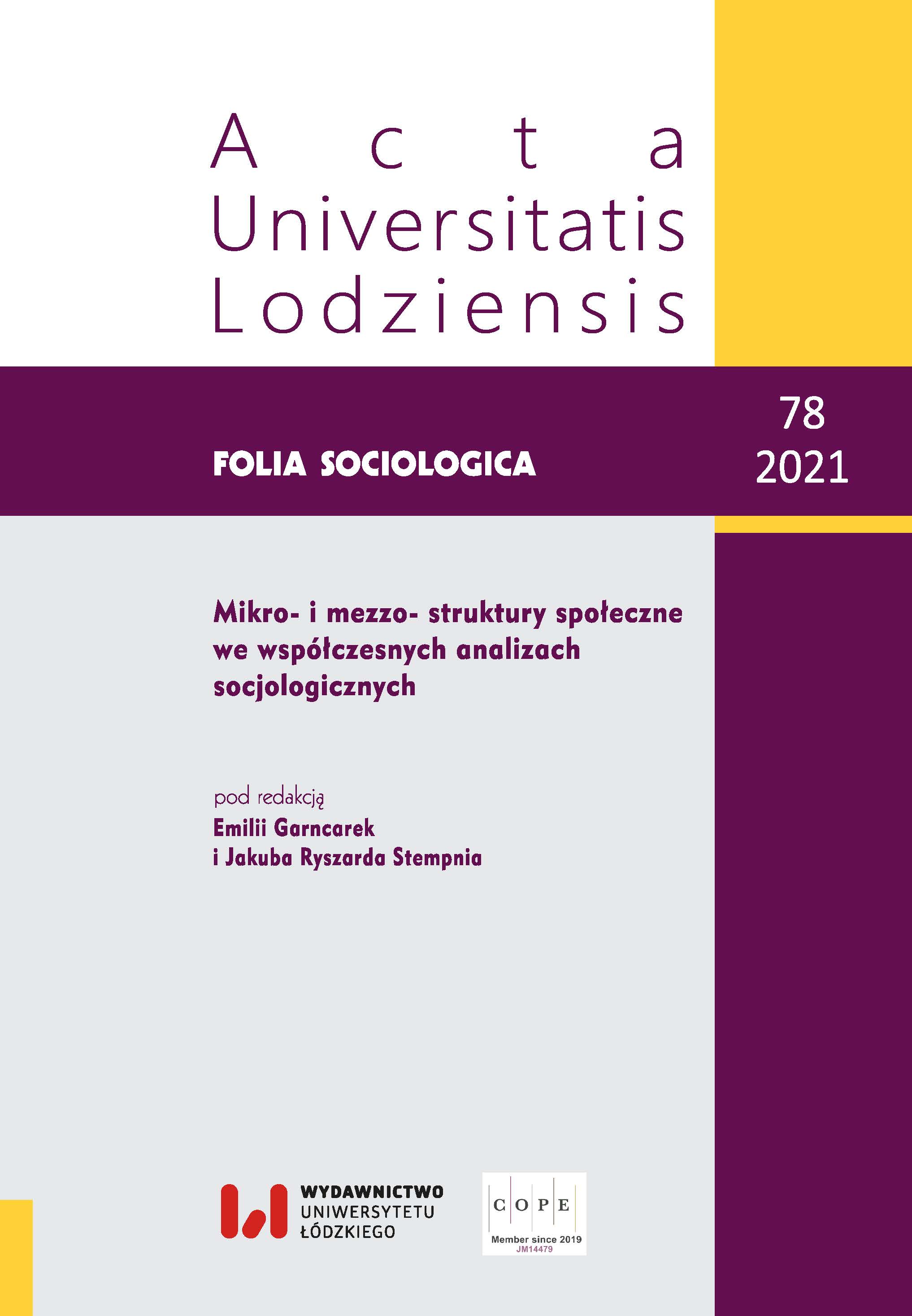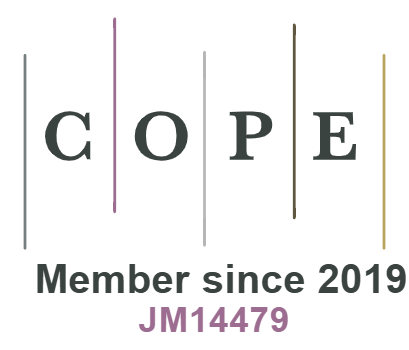Powracający do domu: Rekonstrukcja relacji rodzinnych w procesie readaptacji byłych więźniów
DOI:
https://doi.org/10.18778/0208-600X.78.04Słowa kluczowe:
rodziny więźniów, readaptacja więźnia, badania biograficzne, symboliczny interakcjonizmAbstrakt
Artykuł poświęcono problematyce rodzin osób skazanych na karę pozbawienia wolności. Na podstawie rekonstrukcji biografii osób dorosłych, które w okresie dzieciństwa, dorastania i wczesnej dorosłości doświadczyły uwięzienia rodzica, scharakteryzowano różne strategie odbudowy relacji oraz trudności i niepowodzenia związane z przerwaniem i utratą więzi. W badaniu posłużono się jakościowymi strategiami analiz socjologicznych, wykorzystując potencjał interpretatywnych badań biograficznych. W ramach projektu przeprowadzono 31 wywiadów narracyjnych z osobami, które doświadczyły w przeszłości izolacji penitencjarnej swojego rodzica (dorosłe dzieci więźniów między 18. a 70. rokiem życia).
Bibliografia
Ager A., Strang A. (eds.) (2004), Indicators of Integration: Final Report, “Home Office Development and Practice Report”, no. 28.
Google Scholar
Akers R.L., Hayner N.S., Gruninger W. (1977), Prisonization in five countries: Type of prison and inmate characteristics, “Criminology”, vol. 14(4), pp. 527–554, https://doi.org/10.1111/j.1745-9125.1977.tb00042.X
Google Scholar
DOI: https://doi.org/10.1111/j.1745-9125.1977.tb00042.x
Alpert G.P. (1979), Patterns of change in prisonization: A longitudinal analysis, “Criminal Justice and Behavior”, vol. 6(2), pp. 159–74, https://doi.org/10.1177/009385487900600205
Google Scholar
DOI: https://doi.org/10.1177/009385487900600205
Arditti J.A. (2012), Child trauma within the context of parental incarceration: A family process perspective, “Journal of Family Theory & Review”, vol. 4(3), pp. 181–219, https://doi.org/10.1111/j.1756-2589.2012.00128.X
Google Scholar
DOI: https://doi.org/10.1111/j.1756-2589.2012.00128.x
Arditti J.A., Savla J. (2015), Parental Incarceration and Child Trauma Symptoms in Single Caregiver Homes, “Journal of Child and Family Studies”, no. 24, pp. 551–561, https://doi.org/10.1007/s10826-013-9867-2
Google Scholar
DOI: https://doi.org/10.1007/s10826-013-9867-2
Arditti J.A., Smock S., Parkman T.S. (2005), “It’s Been Hard to Be a Father”: A Qualitative Exploration of Incarcerated Fatherhood, “Fathering”, vol. 3(3), pp. 267–288, https://doi.org/10.3149/fth.0303.267
Google Scholar
DOI: https://doi.org/10.3149/fth.0303.267
Atkin-Plunk C.A., Cramer R.J. (2012), Ex-offenders on the Stand: Steps toward Eliminating Jury Bias, “Journal of Forensic Psychology Practice”, vol. 12(3), pp. 211–226, https://doi.org/10.1080/15228932.2012.674468
Google Scholar
DOI: https://doi.org/10.1080/15228932.2012.674468
Baker J., McHale J., Strozier A.L., Cecil D. (2010), Mother – Grandmother coparenting relationships in families with incarcerated mothers: a pilot investigation, “Family Process”, vol. 49(2), pp. 165–184, https://doi.org/10.1111/j.1545-5300.2010.01316.X
Google Scholar
DOI: https://doi.org/10.1111/j.1545-5300.2010.01316.x
Becker H.S. (1963), Outsiders. Studies in the sociology of deviance, Free Press of Glencoe, New York.
Google Scholar
Berg M.T., Huebner B.M. (2011), Reentry and the Ties That Bind: An Examination of Social Ties, Employment, and Recidivism, “Justice Quarterly”, vol. 28(2), pp. 382–410, https://doi.org/10.1080/07418825.2010.498383
Google Scholar
DOI: https://doi.org/10.1080/07418825.2010.498383
Biel K. (2018), Determinanty readaptacji społecznej w narracjach byłych skazanych z Centrum Integracji “Pro Domo” w Krakowie, “Studia Paedagogica Ignatiana”, vol. 21(1), pp. 159–174, https://doi.org/10.12775/Spi.2018.1.007
Google Scholar
DOI: https://doi.org/10.12775/SPI.2018.1.007
Blumer H. (1969), Symbolic Interactionism. Perspective and Method, Prentice-Hall, Englewood Cliffs.
Google Scholar
Bocknek E.L., Sanderson J., Britner P.A. (2009), Ambiguous loss and posttraumatic stress in school-age children of prisoners, “Journal of Child and Family Studies”, vol. 18(3), pp. 323–333, https://doi.org/10.1007/s10826-008-9233-y
Google Scholar
DOI: https://doi.org/10.1007/s10826-008-9233-y
Bonta J., Andrews D.A. (eds.) (2007), Risk-Need-Responsivity Model for Offender Assessment and Rehabilitation, Public Safety Canada, Canada.
Google Scholar
Bruns A. (2017), Consequences of partner incarceration for women’s employment, “Journal of Marriage and Family”, vol. 79(5), pp. 1331–1352, https://doi.org/10.1111/jomf.12412
Google Scholar
DOI: https://doi.org/10.1111/jomf.12412
Butler T., Kariminia A., Levy M., Murphy M. (2004), The self-reported health status of prisoners in New South Wales, “Australian and New Zealand Journal of Public Health”, vol. 28(4), pp. 344–350, https://doi.org/10.1111/j.1467-842x.2004.tb00442.X
Google Scholar
DOI: https://doi.org/10.1111/j.1467-842X.2004.tb00442.x
Chomczyński P. (2012), Paradygmat interpretatywny, [in:] K. Konecki, P. Chomczyński (eds.), Słownik socjologii jakościowej, pp. 211–214, Difin, Warszawa.
Google Scholar
Christian J. (2005), Riding the Bus. Barriers to Prison Visitation and Family Management Strategies, “Journal of Contemporary Criminal Justice”, vol. 21(1), pp. 31–48, https://doi.org/10.1177/1043986204271618
Google Scholar
DOI: https://doi.org/10.1177/1043986204271618
Chui W.H. (2015), Voices of the incarcerated father: Struggling to live up to fatherhood, “Criminology and Criminal Justice”, vol. 16(1), pp. 60–79, https://doi.org/10.1177/1748895815590201
Google Scholar
DOI: https://doi.org/10.1177/1748895815590201
Clemmer D. (1940), The prison community, Holt, Rinehart and Winston, New York.
Google Scholar
Codd H. (2002), ‘The Ties that Bind’: Feminist Perspectives on Self-Help Groups for Prisoners’ Partners, “The Howard Journal of Criminal Justice”, vol. 41(4), pp. 334–347, https://doi.org/10.1111/1468-2311.00248
Google Scholar
DOI: https://doi.org/10.1111/1468-2311.00248
Codd H. (2003), Women inside and out: Prisoners’ Partners, Women in prison and the struggle for Identity, “Internet Journal of Criminology”, pp. 1–24.
Google Scholar
Cohran J.C., Siennick S.E., Mears D.P. (2018), Social exclusion and parental incarceration impacts on adolescents’ networks and school engagement, “Journal of Marriage and Family”, vol. 80(2), pp. 478–498, https://doi.org/10.1111/jomf.12464
Google Scholar
DOI: https://doi.org/10.1111/jomf.12464
Creswell J. (2007), Qualitative Inquiry & Research Design. Choosing Among Five Approaches, Sage Publications, Thousand Oaks.
Google Scholar
Eshareturi C., Serrant-Green L., Bayliss-Pratt L., Galbraith V. (2013), The case for nurses as central providers of health and social care services for ex-offenders: a discussion paper, “Journal of Advanced Nursing”, vol. 70(5), pp. 1030–1039, https://doi.org/10.1111/jan.12270
Google Scholar
DOI: https://doi.org/10.1111/jan.12270
Fidelus A. (2012), Determinanty readaptacji społecznej skazanych, Wydawnictwo Uniwersytetu Kardynała Stefana Wyszyńskiego, Warszawa.
Google Scholar
Goffman E. (1959), The Moral Career of the Mental Patient, “Psychiatry: Journal for the Study of Interpersonal Processes”, vol. 22, pp. 123–142, https://doi.org/10.1080/00332747.1959.11023166
Google Scholar
DOI: https://doi.org/10.1080/00332747.1959.11023166
Goffman E. (1961), Asylums: Essays on the Social Situation of Mental Patients and Other Inmates, Anchor Books, New York.
Google Scholar
Guest G., Bunce A., Johnson L. (2006), How Many Interviews Are Enough? An Experiment with Data Saturation and Variability, “Field Methods”, vol. 18(1), pp. 59–82, https://doi.org/10.1177/1525822X05279903
Google Scholar
DOI: https://doi.org/10.1177/1525822X05279903
Hald Andersen S., Wildeman Ch. (2014), The Effect of Paternal Incarceration on Children’s Risk of Foster Care Placement, “Social Forces”, vol. 93(1), pp. 269–298, https://doi.org/10.1093/ sf/sou027
Google Scholar
DOI: https://doi.org/10.1093/sf/sou027
Hissel S., Bijleveld C., Kruttschnitt C. (2011), The well-being of children of incarcerated mothers: An exploratory study for the Netherlands, “European Journal of Criminology”, vol. 8(5), pp. 346–360, https://doi.org/10.1177/1477370811415755
Google Scholar
DOI: https://doi.org/10.1177/1477370811415755
Holzer H.J., Raphael S., Stoll M.A. (2003), Employment Barriers Facing Ex-offenders, [in:] Employment Dimensions of Reentry: Understanding the Nexus between Prisoner Reentry and Work, New York University Law School, May 19–20, https://doi.org/10.1037/e717782011-001
Google Scholar
DOI: https://doi.org/10.1037/e717782011-001
Hoskins Z. (2014), Ex‐offender Restrictions, “Journal of Applied Philosophy”, vol. 31(1), pp. 33–48, https://doi.org/10.1111/japp.12028
Google Scholar
DOI: https://doi.org/10.1111/japp.12028
Irish Penal Report Trust Position (IPRT) (2012), The vicious circle of social exclusion and crime: Ireland’s Disproportionate Punishment of the Poor, January, https://www.iprt.ie
Google Scholar
Jarrett N.C., Adeyemi S.A., Huggins T. (2006), Bridging the gap: providing health care to newly released men, “Journal of Health Care for the Poor and Underserved”, vol. 17(1), pp. 70–80, https://doi.org/10.1353/hpu.2006.0008
Google Scholar
DOI: https://doi.org/10.1353/hpu.2006.0008
Johnson E.I., Easterling B. (2012), Understanding Unique Effects of Parental Incarceration on Children: Challenges, Progress, and Recommendations, “Journal of Marriage and Family”, vol. 74(2), pp. 342–356, https://doi.org/10.1111/j.1741-3737.2012.00957.X
Google Scholar
DOI: https://doi.org/10.1111/j.1741-3737.2012.00957.x
Johnson E.I., Waldfogel J. (2002), Parental Incarceration: Recent Trends and Implications for Child Welfare, “Social Service Review”, vol. 76(3), pp. 460–479, https://doi.org/10.1086/341184
Google Scholar
DOI: https://doi.org/10.1086/341184
Johnston D. (1995), Effect of parental incarceration, [in:] K. Gabel, D. Johnston (eds.), Children of Incarcerated Parents, Lexington Books, New York–London–Toronto, pp. 59–88.
Google Scholar
Kacprzak A. (2017), Bezdomność przestępcy (w świetle badań i analizach socjologicznych i kryminologicznych), [in:] I. Kuźma, Ł. Lange (eds.), Mieszkanie i dom jako nieoczywistość kulturowo-społeczna, Wydawnictwo LangeL – Łucja Lange, Łódź, pp. 270–287.
Google Scholar
Kacprzak A., Kudlińska I. (2014), Praca socjalna z osobami opuszczającymi placówki resocjalizacyjne i ich rodzinami, Centrum Rozwoju Zasobów Ludzkich, Warszawa.
Google Scholar
Kaźmierska K. (2013), Badania biograficzne w naukach społecznych, “Przegląd Socjologii Jakościowej”, vol. 9(4), pp. 6–10.
Google Scholar
Kaźmierska K. (2014), The Autobiographical Narrative Interview – Ethical and Methodological Issues in the Context of Narratives’ Archiving, “Studia Socjologiczne”, vol. 3(214), pp. 221–238.
Google Scholar
Kohli M. (1981), Biography: Account, Text, Method, [in:] D. Bertaux (ed.), Biography and Society. The Life History Approach in the Social Science, Sage, Thousand Oaks, pp. 61–75.
Google Scholar
Lowenstein A. (1984), Coping with Stress: The Case of Prisoners’ Wives, “Journal of Marriage and the Family”, vol. (46)3, pp. 699–708, https://doi.org/10.2307/352611
Google Scholar
DOI: https://doi.org/10.2307/352611
Lynch J.P., Sabol W.J. (2001), Prisoner Reentry in Perspective, “Crime Policy Report”, vol. 3, The Urban Institute Justice Policy Center, Washington, DC.
Google Scholar
Marshall B., Cardon P., Poddar A., Fontenot R. (2013), Does sample size matter in qualitative research? A review of qualitative interviews in is research, “Journal of Computer Information System”, vol. 54(1), pp. 11–22, https://doi.org/10.1080/08874417.2013.11645667
Google Scholar
DOI: https://doi.org/10.1080/08874417.2013.11645667
Miszewski K. (2016), Zabójcy w więzieniu: adaptacja więźniów długoterminowych do warunków izolacji, Oficyna Naukowa, Warszawa.
Google Scholar
Pasikowski S. (2015), Granice teoretycznego nasycenia, “Rocznik Lubuski”, vol. 41(1), pp. 33–40.
Google Scholar
Paterline B.A., Orr D. (2016), Adaptation to Prison and Inmate Self-Concept, “Journal of Psychology and Behavioral Science”, vol. 4(2), pp. 70–79, https://doi.org/10.15640/jpbs.v4n2a6
Google Scholar
DOI: https://doi.org/10.15640/jpbs.v4n2a6
Petersilia J. (2003), How we hinder: Legal and practical barriers to reintegration, [in:] J. Petersilia (ed.), When Prisoners Come Home: Parole and Prisoner Reentry, Oxford University Press, New York, pp. 105–138, https://doi.org/10.1093/acprof:oso/9780195160864.003.0006
Google Scholar
DOI: https://doi.org/10.1093/acprof:oso/9780195160864.003.0006
Petersilia J. (2004), What Works in Prisoner Reentry? Reviewing and Questioning the Evidence, “Federal Probation. A Journal of Correctional Philosophy and Practice”, vol. 68(2), pp. 4–7.
Google Scholar
Rosenthal G. (2012), Badania biograficzne, [in:] K. Kaźmierska (ed.), Metoda biograficzna w socjologii: antologia tekstów, Zakład Wydawniczy Nomos, Kraków, pp. 279–307.
Google Scholar
Schütze F. (2012), Analiza biograficzna ugruntowana empirycznie w autobiograficznym wywiadzie narracyjnym. Jak analizować autobiograficzne wywiady narracyjne, [in:] K. Kaźmierska (ed.), Metoda biograficzna w socjologii: antologia tekstów, Zakład Wydawniczy Nomos, Kraków, pp. 141–278.
Google Scholar
Shaw C.R. (1930), The Jack-Roller: A Delinquent Boy’s Own Story, University of Chicago Press, Chicago.
Google Scholar
Shaw C.R., Moore M.E. (eds.) (1931), The Natural History of Delinquent Career, University of Chicago Press, Chicago, https://doi.org/10.1037/13522-000
Google Scholar
DOI: https://doi.org/10.1037/13522-000
Solinas-Saunders M., Stacer M.J., Guy R. (2015), Ex-offender barriers to employment: racial disparities in labor markets with asymmetric information, “Journal of Crime and Justice”, vol. 38(2), pp. 249–269, https://doi.org/10.1080/0735648X.2013.870492
Google Scholar
DOI: https://doi.org/10.1080/0735648X.2013.870492
Sutherland E.H. (1949), White Collar Crime, Holt, Rinehart & Winston, New York.
Google Scholar
Swisher R.R., Roettger M.E. (2012), Father’s Incarceration and Youth Delinquency and Depression: Examining Differences by Race and Ethnicity, “Journal of Research on Adolescence”, vol. 22(4), pp. 597–603, https://doi.org/10.1111/j.1532-7795.2012.00810.X
Google Scholar
DOI: https://doi.org/10.1111/j.1532-7795.2012.00810.x
Sykes G.M., Matza D. (1957), Techniques of neutralization: A theory of delinquency, “American Sociological Review”, vol. 22(6), pp. 664–670, https://doi.org/10.2307/2089195
Google Scholar
DOI: https://doi.org/10.2307/2089195
Szczepanik R. (2015a), Stawanie się recydywistą: kariery instytucjonalne osób powracających do przestępczości, Wydawnictwo Uniwersytetu Łódzkiego, Łódź.
Google Scholar
DOI: https://doi.org/10.18778/7969-685-7
Szczepanik R. (2015b), Partnerki życiowe recydywistów i ich rola w powstrzymywaniu aktywności przestępczej, “Profilaktyka Społeczna i Resocjalizacja”, vol. 26, pp. 35–57.
Google Scholar
Szczepanik R., Siebert S. (2015), The Triple Bind of Narration: Fritz Schütze’s Biographical Interview in Prison Research and Beyond, “Sociology”, vol. 50(2), pp. 285–300, https://doi.org/10.1177/0038038515570145
Google Scholar
DOI: https://doi.org/10.1177/0038038515570145
Tasca M., Rodriguez N., Zatz M.S. (2011), Family and Residential Instability in the Context of Paternal and Maternal Incarceration, “Criminal Justice and Behavior”, vol. 38(3), pp. 231–247, https://doi.org/10.1177/0093854810391632
Google Scholar
DOI: https://doi.org/10.1177/0093854810391632
Travis J. (2000), But They All Come Back; Rethinking Prisoner Reentry, “Sentencing and Corrections”, no. 7, U.S. Department of Justice.
Google Scholar
Turney K. (2014), The Intergenerational Consequences of Mass Incarceration: Implications for Children’s Co-residence and Contact with Grandparents, “Social Forces”, vol. 93(1), pp. 299–327, https://doi.org/10.1093/sf/sou062
Google Scholar
DOI: https://doi.org/10.1093/sf/sou062
Visher C., Debus S., Yahner J. (2008), Employment after Prison: A Longitudinal Study of Releases in Three States. Research Brief, Urban Institute, Justice Policy Center.
Google Scholar
Wengraf T. (2012), Interpretacja historii życiowych, sytuacji życiowych i doświadczeń osobistych: biograficzno-narracyjna metoda interpretacyjna (BNIM), [in:] K. Kaźmierska (ed.), Metoda biograficzna w socjologii: antologia tekstów, Zakład Wydawniczy Nomos, Kraków, pp. 351–362.
Google Scholar
Pobrania
Opublikowane
Jak cytować
Numer
Dział
Licencja

Utwór dostępny jest na licencji Creative Commons Uznanie autorstwa – Użycie niekomercyjne – Bez utworów zależnych 4.0 Międzynarodowe.










